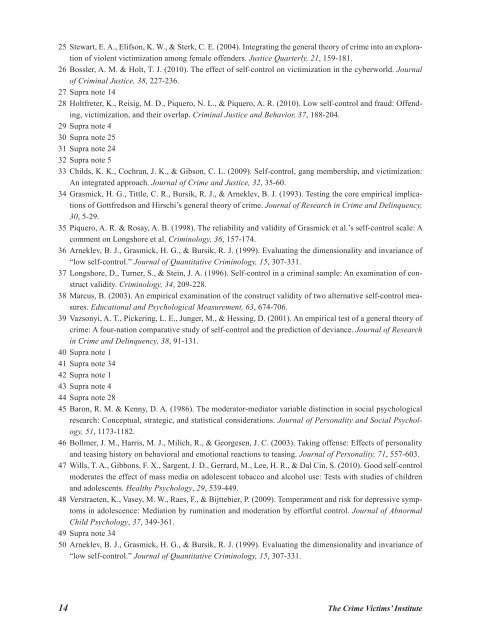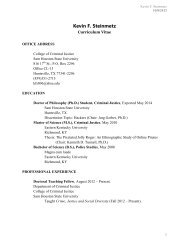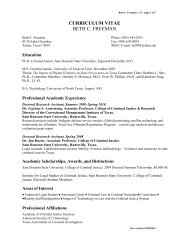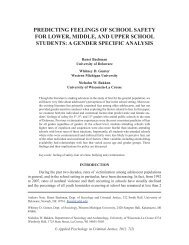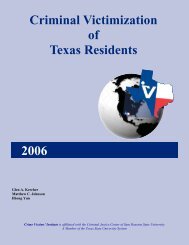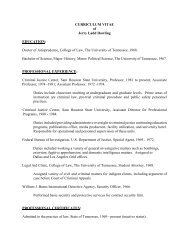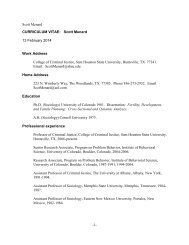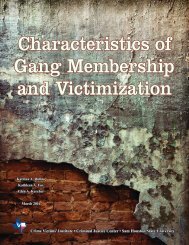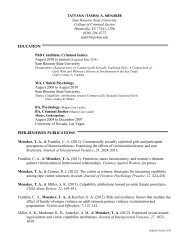Understanding How Some Victims Become Perpetrators: Self ...
Understanding How Some Victims Become Perpetrators: Self ...
Understanding How Some Victims Become Perpetrators: Self ...
You also want an ePaper? Increase the reach of your titles
YUMPU automatically turns print PDFs into web optimized ePapers that Google loves.
25 Stewart, E. A., Elifson, K. W., & Sterk, C. E. (2004). Integrating the general theory of crime into an explorationof violent victimization among female offenders. Justice Quarterly, 21, 159-181.26 Bossler, A. M. & Holt, T. J. (2010). The effect of self-control on victimization in the cyberworld. Journalof Criminal Justice, 38, 227-236.27 Supra note 1428 Holtfreter, K., Reisig, M. D., Piquero, N. L., & Piquero, A. R. (2010). Low self-control and fraud: Offending,victimization, and their overlap. Criminal Justice and Behavior, 37, 188-204.29 Supra note 430 Supra note 2531 Supra note 2432 Supra note 533 Childs, K. K., Cochran, J. K., & Gibson, C. L. (2009). <strong>Self</strong>-control, gang membership, and victimization:An integrated approach. Journal of Crime and Justice, 32, 35-60.34 Grasmick, H. G., Tittle, C. R., Bursik, R. J., & Arneklev, B. J. (1993). Testing the core empirical implicationsof Gottfredson and Hirschi’s general theory of crime. Journal of Research in Crime and Delinquency,30, 5-29.35 Piquero, A. R. & Rosay, A. B. (1998). The reliability and validity of Grasmick et al.’s self-control scale: Acomment on Longshore et al. Criminology, 36, 157-174.36 Arneklev, B. J., Grasmick, H. G., & Bursik, R. J. (1999). Evaluating the dimensionality and invariance of“low self-control.” Journal of Quantitative Criminology, 15, 307-331.37 Longshore, D., Turner, S., & Stein, J. A. (1996). <strong>Self</strong>-control in a criminal sample: An examination of constructvalidity. Criminology, 34, 209-228.38 Marcus, B. (2003). An empirical examination of the construct validity of two alternative self-control measures.Educational and Psychological Measurement, 63, 674-706.39 Vazsonyi, A. T., Pickering, L. E., Junger, M., & Hessing, D. (2001). An empirical test of a general theory ofcrime: A four-nation comparative study of self-control and the prediction of deviance. Journal of Researchin Crime and Delinquency, 38, 91-131.40 Supra note 141 Supra note 3442 Supra note 143 Supra note 444 Supra note 2845 Baron, R. M. & Kenny, D. A. (1986). The moderator-mediator variable distinction in social psychologicalresearch: Conceptual, strategic, and statistical considerations. Journal of Personality and Social Psychology,51, 1173-1182.46 Bollmer, J. M., Harris, M. J., Milich, R., & Georgesen, J. C. (2003). Taking offense: Effects of personalityand teasing history on behavioral and emotional reactions to teasing. Journal of Personality, 71, 557-603.47 Wills, T. A., Gibbons, F. X., Sargent, J. D., Gerrard, M., Lee, H. R., & Dal Cin, S. (2010). Good self-controlmoderates the effect of mass media on adolescent tobacco and alcohol use: Tests with studies of childrenand adolescents. Healthy Psychology, 29, 539-449.48 Verstraeten, K., Vasey, M. W., Raes, F., & Bijttebier, P. (2009). Temperament and risk for depressive symptomsin adolescence: Mediation by rumination and moderation by effortful control. Journal of AbnormalChild Psychology, 37, 349-361.49 Supra note 3450 Arneklev, B. J., Grasmick, H. G., & Bursik, R. J. (1999). Evaluating the dimensionality and invariance of“low self-control.” Journal of Quantitative Criminology, 15, 307-331.14The Crime <strong>Victims</strong>’ Institute


